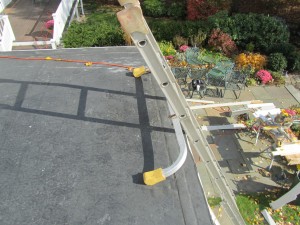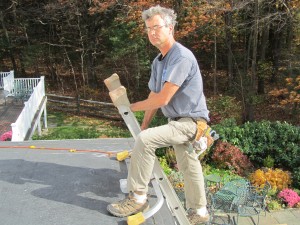Ladder Safety Tips
Each year in the U.S., accidents involving ladders cause an estimated 300 deaths and 130,000 injuries requiring emergency medical attention. Ladder accidents usually are caused by improper selection, care or use and not by manufacturing defects. Learn a few Ladder Safety Tips and cdecrease your chance of injury.
 Some of the more common hazards involving ladders, such as instability, electrical shock, and falls, can be predicted and prevented.
Some of the more common hazards involving ladders, such as instability, electrical shock, and falls, can be predicted and prevented.
Prevention requires proper planning, correct ladder selection, good work procedures and adequate ladder maintenance. Check out these Ladder Safety Tips:
Ladder Safety Tips
- Make sure the ladder is suited for the type of job you plan to do and sized properly. That means that it comfortable reaches the height you need without you needing to step travel past the top third rung.
- Place your ladder on a stable, even, flat surface. Never place a ladder on top of another object.
- Use the 1:4 ratio to ensure a stable working platform. Place the base of the ladder 1 foot away of whatever it leans against for every 4 feet of height to the point where the ladder contacts at the top
- When using an A-frame stepladder, make sure the brace is locked in place.
- If climbing onto another surface, make sure the ladder extends at least three feet past the platform you’re climbing onto.

- Secure tall ladders by lashing or fastening the ladder to prevent movement.
- Always face the ladder when climbing or descending.
- Keep both feet on the ladder – never put one foot on a rung and the other foot on a different surface.
- Do not climb higher than the second rung on stepladders or the third rung on straight or extension ladders.
- Never stand on the top or the paint shelf of a stepladder.
- The distance from the base of the house to the base of the ladder should be 1/4 the height of the ladder.
- It is extremely important to make sure the ladder’s foot pads are secure on the ground. Shim if necessary. If you are on grass I recommend tilting the foot pads and sink the ladder into the ground a bit by stepping / hopping on the first step and using your weight to set the ladder.
- Keep ladders away from electrical lines and pay attention to overhead lines when moving the ladder from one location to another or into into position.
Never attempt to stretch while on a ladder, set the ladder up in the middle of where you would like to work. If you can’t reach, move the ladder. - Use stabilizer bars to steady your ladder.
TIP: When working on a roof place your stabilizer lower on the ladder to allow you to have additional rungs to hold onto as you enter and exit the ladder. See photo on right.
LADDER SELECTION
Portable ladders are designed as “one-man” equipment with the proper strength to support the worker as well as his tools and materials. Ladders are constructed under three general classes:
- Type I Industrial
Heavy-duty with a load capacity not more than 250 pounds. - Type II Commercial
Medium-duty with a load capacity not more than 225 pounds (suited for painting and similar tasks). - Type III Household
Light-duty with a load capacity of 200 pounds.









